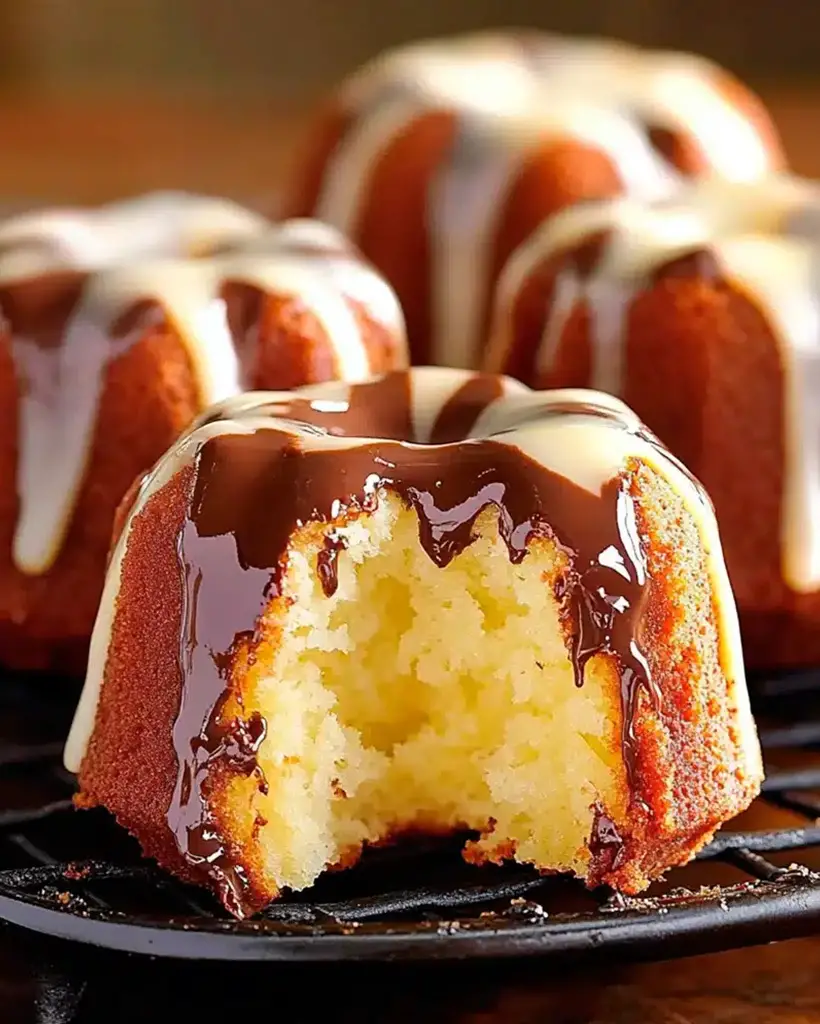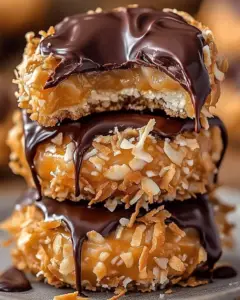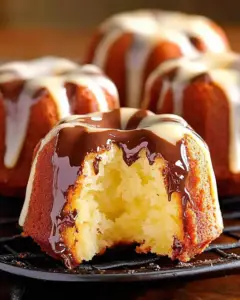Delightful Mini Bundt Cakes: A Treat for Any Occasion
Mini Bundt Cakes are the perfect dessert for those who crave a delightful sweet treat without the guilt of overindulging. These charming cakes, baked in adorable mini Bundt pans, combine the rich flavors of vanilla and a hint of almond to deliver a moist, tender bite every time. Ideal for tea parties, festive gatherings, or simply a weekend treat, these mini Bundt cakes are sure to impress your family and friends.
Each bite of these Mini Bundt Cakes bursts with flavor, making them irresistible. The light, fluffy texture combined with the subtle vanilla undertones creates an unforgettable taste sensation. Their petite size means they are not only visually appealing but also easy for portion control. Whether you serve them with a dusting of powdered sugar, a drizzle of glaze, or a dollop of whipped cream, their charm is undeniable.
Quick Recipe Highlights
Flavor Profile
- The flavor of these mini Bundt cakes is predominantly vanilla with an inviting hint of almond.
- The combination of the two flavors creates a warm, comforting taste that is both familiar and refined.
Texture
- The texture is light and airy with a moist crumb that melts in the mouth.
- The cakes are tender, offering a satisfying chewiness that is complemented by any chosen icing or glaze.
Aroma
- When baking these Mini Bundt Cakes, your kitchen will be filled with the soothing aroma of vanilla.
- This aromatic delight lingers in the air, inviting anticipation for the first bite.
Visual Appeal
- The mini Bundt cakes boast a golden-brown exterior that glistens with or without icing.
- Their shape adds elegance to their presentation, making them a standout on any dessert table.
Skill Level Needed
- Easy enough for novice bakers yet rewarding for seasoned professionals.
- No complicated techniques are necessary, making these cakes accessible to all skill levels.
Special Equipment
- A mini Bundt cake pan is essential to achieve their iconic shape.
- Other than that, a hand mixer or stand mixer and basic baking tools are all that’s required.
Recipe Overview
Difficulty Level
- The simplicity of this recipe makes it ideal for beginners, explaining its easy difficulty level.
- With straightforward steps and common ingredients, anyone can create these delightful treats.
Category
- These Mini Bundt Cakes fall under desserts but are also suitable as a snack.
- Perfect for post-meal indulgence or a sweet surprise during the day.
Cuisine
- While primarily rooted in American baking, these cakes take inspiration from French pâtisserie with their elegant shape.
- This recipe brings a touch of European flair to an American classic.
Cost
- The cost for ingredients is relatively low, making these cakes a budget-friendly dessert option.
- Most ingredients are pantry staples, keeping additional expenses minimal.
Season
- Mini Bundt Cakes are versatile enough to be enjoyed in any season.
- However, they’re particularly delightful during the spring and summer months when accompanied by fresh fruit.
Occasion
- Whether for a birthday, holiday, or simply a weekend treat, these cakes suit any occasion.
- Their elegant presentation makes them ideal for celebratory events like birthdays and weddings.
Why You’ll Love This Recipe
Taste and texture are perfectly balanced in these Mini Bundt Cakes, offering a delightful experience with every bite. The interplay between the moist, tender crumb and the rich vanilla flavor creates a satisfying mouthfeel. These cakes are conveniently portioned, making them easy to serve and enjoy without the pressure of cutting or plating a larger cake.
In terms of preparation, this recipe excels in simplicity. With just a handful of steps, it is friendly for busy schedules and kitchen novices alike. You’ll find that assembling these cakes is a breeze, and cleanup is minimal. Nutritionally, choosing quality ingredients like real vanilla extract and almond flour can add a healthy twist, increasing fiber and protein content.
Socially, these cakes shine when shared. They’re a hit at parties and family gatherings, often inspiring requests for the recipe. Their beauty and allure make them highly Instagram-worthy, adding a modern flair to your social media feed.
Lastly, these Mini Bundt Cakes are cost-effective. The simple ingredient list means you’re not breaking the bank, yet the end result is a luxurious treat that feels special and celebratory. This combination of accessibility, flavor, and appeal ensures that this recipe will become a staple in your kitchen.
Historical Background and Cultural Significance
The Bundt cake originated in Europe, with early versions tracing back to Germany and Austria. These were called “Gugelhupf” and typically featured yeast-based doughs enriched with fruit or nuts. As time passed, the Bundt cake evolved in American households, shaping the sweet, dense versions popular today.
Mini Bundt Cakes emerged as a popular variant due to their ease of serving and appealing presentation. Their cultural importance remains strong, representing a blend of European tradition and American creativity. Over the years, their evolution has seen variations incorporating diverse flavors from chocolate to citrus, signifying their adaptability to modern palates.
Regionally, the Mini Bundt Cake takes many forms. In the southern United States, they might be flavored with pecans or caramel, while in New England, you might find versions with cranberries or maple syrup. The recipe’s flexibility has allowed it to thrive, a staple across diverse culinary landscapes.
Ingredient Deep Dive
Vanilla is a cornerstone of this Mini Bundt Cake recipe, both for its fragrant aroma and warm, soothing flavor. Widely used in baking, it has historical roots in Mesoamerican cuisine and remains a luxury ingredient due to its labor-intensive cultivation.
Nutritionally, vanilla doesn’t boast significant benefits beyond flavor, but selecting pure vanilla extract ensures quality. Storage should be in a cool, dark place to maintain potency, and if out of vanilla, almond extract serves as a fitting substitute.
Another key ingredient is flour, specifically all-purpose, serving as the structural foundation of the cakes. Flour’s history dates back millennia, central to breads and pastries worldwide. In these cakes, it provides the necessary gluten for structure, while alternative options like almond or coconut flour can cater to dietary needs.
Eggs contribute to both structure and moisture in the cakes. Their protein content provides texture, while their emulsifying properties create a stable mixture. Fresh eggs are crucial, and room temperature is best for consistency. In vegan adaptations, flaxseed or applesauce often stand in for eggs.
Common Mistakes to Avoid
- Overmixing the batter can lead to dense cakes. Mix just until combined to maintain a light texture.
- Not greasing the pan well can cause sticking. Be generous with your greasing method, especially in the crevices.
- Overbaking will dry the cakes out. Monitor closely and use a toothpick to check doneness.
- Ignoring ingredient temperature can affect consistency. Ensure eggs and butter are at room temperature.
- Substituting baking powder for baking soda without adjusting the recipe won’t yield the same rise.
- Skipping the cooling step in the pan could result in breakage. Allow the cakes to set before removing.
- Underfilling the Bundt pans will lead to squat cakes. Fill each mold to the recommended level.
- Using cold ingredients can prevent proper emulsification. Plan ahead for ingredient prep.
Essential Techniques
Proper mixing technique is crucial for achieving the ideal cake texture. Mixing involves folding the wet and dry ingredients together to the right consistency, avoiding overworking the gluten, which would otherwise result in dense cakes. Visual cues include a smooth, lump-free batter.
Greasing and flouring the pans correctly ensures the Mini Bundt Cakes release effortlessly. Use butter to coat every crevice, followed by a dusting of flour, shaking off the excess. This method prevents sticking, maintaining the cakes’ perfect shape.
Temperature control during the mixing and baking processes can’t be understated. Maintaining room temperature ingredients helps create a uniform batter, and baking at the precise suggested temperature ensures even cooking without burning the exterior.
Pro Tips for Perfect Mini Bundt Cakes
Make sure your butter is at the ideal consistency—softened but not melting. This ensures it’s easily creamed with sugar, promoting a light, airy texture.
Accurate portioning is key. Use a cookie scoop for consistent batter distribution across the mini Bundt pans, ensuring even baking.
Allow the cakes to cool for 10-15 minutes in the pan before attempting to remove them. This cooling period helps them set and makes for easy un-molding.
Consider experimenting with different flavored extracts or zest in the batter for a personalized touch. Citrus zests like lemon or orange complement vanilla beautifully.
Don’t skimp on quality vanilla extract. Pure vanilla brings out the best flavor as opposed to imitation varieties.
For added flair, consider drizzling a simple glaze over the mini cakes or topping them with fresh fruit for peparation and additional depth of flavor.
Variations and Adaptations
Regional variations in Mini Bundt Cakes include bundtinis with chocolate chips or seasonal fruit inclusions like blueberries or cranberries. Adapting these cakes for the season is easy: think pumpkin spice for fall or zesty lemon for spring.
For dietary modifications, almond or coconut flour can replace all-purpose flour, and flax eggs or applesauce can act as egg substitutes, making this recipe adaptable for gluten-free or vegan diets.
Enhancing flavors is as simple as adding a hint of espresso powder for mocha depth or swapping vanilla extract with peppermint during the holidays. Texture modifications often come from additions like nuts or dried fruit, which introduce a pleasant chew in contrast to the cakes’ softness.
When reimagining presentation, consider layered mini Bundt cakes with fresh cream or engaging toppings like toasted coconut, elevating their visual appeal and inviting exploration of new textures.
Serving and Presentation Guide
For elegance, plate the Mini Bundt Cakes on tiered stands, showcasing their delightful shape and golden color. Garnishing with edible flowers or herbs like mint adds vibrant color and fragrant contrasts.
Traditional accompaniments include light whipped cream or rich vanilla ice cream, complementing the cakes’ flavors without overpowering them. For a modern angle, serve with a fresh berry compote or a bold chocolate drizzle.
Salvaging maximum enjoyment means focusing on temperature considerations. These cakes can be served warm to amplify their aroma, but they also retain their moistness at room temperature. Portion control is simplified with these mini versions, allowing for easy serving adjustments depending on the occasion.
Wine and Beverage Pairing
A delicate sparkling wine pairs beautifully with these Mini Bundt Cakes, with a crisp prosecco highlighting the light vanilla flavors. For those avoiding alcohol, a chilled lavender lemonade can achieve a similarly refreshing balance.
Coffee, particularly a mild roast, serves as an excellent accompaniment by enhancing the cake’s warmth and inviting complexity. When serving hot beverages, ensure they are not overpoweringly strong, as this could mask the cakes’ subtle flavors.
Temperature matters in pairings; serving beverages slightly cooler helps refresh the palate, enhancing the cakes’ enjoyment. These cakes lend themselves well to afternoon teas where an aromatic Earl Grey or chamomile harmonizes with the vanilla tones.
Storage and Shelf Life
To maintain freshness, store Mini Bundt Cakes in an airtight container at room temperature. They will remain moist for up to three days, although refrigeration extends their life to a week. However, refrigeration can alter texture, so allow time to reach room temperature before consuming.
For freezing, ensure the cakes are fully cooled, then wrap individually in plastic wrap and place in a freezer-safe bag. They freeze well for up to two months, with no adverse texture changes when thawed correctly.
Monitor for spoilage signs, such as mold or off-smells. When reheating, particularly from frozen, a gentle oven warming (covered with foil for protection) preserves their moistness. Instant satisfaction is also achievable by microwaving in brief intervals.
Make Ahead Strategies
Prepare separate elements ahead of time, such as the glaze or icing if using, to streamline serving. Cakes can be baked a day ahead, enhancing flavor through development over time.
Store at room temperature in airtight containers, which prevents staling. Reassemble prior to serving—particularly helpful when planning for large gatherings.
Reheating should be gentle to preserve the soft texture, while adding fresh toppings can reinvigorate flavor if made the day before. Elements like edible flowers should be a last-minute addition to preserve their vibrancy.
Scaling Instructions
Halving the recipe is a straightforward adjustment for smaller gatherings. Similarly, doubling or tripling requires only proportional scaling of ingredients, though more pan positions may be needed for even baking.
When scaling up, avoid overbulking kitchen equipment with batter, which can alter baking times and texture. Allow for balanced air circulation between pans if using multiple.
With increased quantities, consider staggered prepping to maintain quality. Additional storage space becomes essential—empty your fridge if using icing requiring cool conditions.
Nutritional Deep Dive
These Mini Bundt Cakes provide a balance of macros, with primary calories from the carbohydrates in flour and sugar. Using almond flour can improve the protein profile and introduce healthy fats.
Micronutrient levels are modest but can be elevated with fruit inclusions or enriched ingredients like fortified dairy. From a health perspective, choosing reduced-sugar options or incorporating whole grains increases nutritional gains without sacrificing taste.
Portion sizes allow for focused indulgence without overeating, and this attention supports weight maintenance. As always, mindful ingredient selection impacts overall dietary goals.
Dietary Adaptations
For gluten-free Mini Bundt Cakes, substitute wheat flour with a blend of gluten-free flours, ensuring binders like xanthan gum are included for structure.
Dairy-free variants are as simple as selecting plant-based creamers and butters that work well in batters. Vegan adaptations benefit from smart swaps like flax eggs to replace traditional eggs.
In low-carb or keto plans, almond or coconut flour can cater to carbohydrate restrictions, although textural differences may occur. Overall, these adaptations are adaptable to ensure inclusive feastings, satisfying various dietary needs without compromising enjoyment.
Troubleshooting Guide
Texture concerns typically stem from overmixing or incorrect leavening usage. Use recommended measurements and avoid overworking the batter to promote airiness. Temperature is crucial; cold ingredients can seize batter, affecting consistency.
Flavor balance is another common pitfall. Imbalanced extracts or low-quality vanillas can lead to off-flavors. Equipment problems often arise when pans are insufficiently greased, requiring careful attention to preventive steps. Ingredient substitutions need precise knowledge—flour types can alter results, as can egg or dairy replacements. Timing discrepancies occur if ovens run too hot or cold, requiring up-to-date equipment calibration.
Recipe Success Stories
Community feedback often highlights the ease and versatility of Mini Bundt Cakes. Creative adaptations shared in reader comments—inserting chocolate chips or a swirl of nut butter into the batter—showcase recipe flexibility.
Variations that have earned praise include festive flavors like cinnamon swirl for winter holidays. Readers frequently applaud how photogenic these cakes become, advising draping them in delicate sugar or fresh fruit for kitchen pride shooting scenarios.
Yet, among all feedback, gratitude for a succinct yet creative recipe keeps universal acclaim, calling these Mini Bundt Cakes a never-fail dessert solution.
Frequently Asked Questions
Can I make these Mini Bundt Cakes ahead of time?
Yes, you can bake these a day in advance. Store them in an airtight container at room temperature and frost them just before serving.
Can I use buttermilk instead of regular milk in the recipe?
Yes, buttermilk adds a lovely tang and can improve the cake’s overall texture, resulting in a tender crumb.
What is a suitable substitute for vanilla extract?
Almond extract provides an appealing alternative, offering a unique twist to the traditional vanilla flavor.
Can I freeze Mini Bundt Cakes?
Absolutely. Wrap them individually in plastic and store in a freezer-safe bag for up to two months. Thaw overnight before serving.
What’s the best way to tell if the cakes are done?
Insert a toothpick into one of the cakes; if it comes out clean or with a few moist crumbs, they’re done.
What should I do if my cakes stick to the pan?
Ensure thorough greasing and flouring of the pan before baking. If they do stick, run a sharp knife around the edges and carefully invert them.
Why did my cakes come out dense?
Overmixing the batter can cause dense cakes. Mix until just combined to prevent overworking gluten.
Can I use this recipe for a large Bundt cake pan?
Yes, though baking time will increase. Check often toward the end of baking to avoid overcooking.
How can I make these cakes dairy-free?
Substitute plant-based butter and milk products without affecting the texture or taste significantly.
What can I use as a glaze for these cakes?
A simple glaze can be made with confectioners’ sugar and milk, adding lemon zest for added brightness.
Are these Mini Bundt Cakes suitable for kids?
Certainly! The cakes’ size makes them a wonderful kid-friendly treat, imparting portion control naturally.
Do I need to adjust baking for high altitudes?
Yes, you might need adjustments such as reduced baking powder and increased liquids to account for altered temperatures and moisture levels.
Additional Resources
Explore related recipes like full-sized Bundt cakes or try our technique guides to master cake decorating. Look into ingredient guides that provide deeper insight into different flour types appropriate for dietary needs. Equipment recommendations ensure you’re prepared with the best tools for perfect cakes every time, while seasonal variations offer inspiration for flavor combinations suited to any time of year. Expanding your baking repertoire has never been easier with our comprehensive resources.
Print
Mini Bundt Cakes
Description
Deliciously moist mini bundt cakes that can be topped with your favorite glaze or icing.
Ingredients
For the Crust:
- 1 1/2 cups all-purpose flour
- 1 cup granulated sugar
- 1/2 cup butter, melted
- 2 large eggs
- 1/2 cup milk
- 1 teaspoon vanilla extract
- 1 teaspoon baking powder
- 1/4 teaspoon salt
Instructions
1. Prepare the Crust:
- Preheat the oven to 350°F (175°C) and grease the mini bundt cake pans.
- In a bowl, mix melted butter and sugar until smooth.
- Add eggs one at a time, mixing well after each addition.
- Stir in vanilla extract.
- In another bowl, combine flour, baking powder, and salt.
- Gradually add the dry ingredients to the wet mixture alternately with milk, starting and ending with flour mixture. Mix until just combined.
- Pour batter into prepared mini bundt pans, filling each about 2/3 full.
- Bake for 18-20 minutes, or until a toothpick inserted into the center comes out clean.
- Allow the cakes to cool in the pans for 10 minutes before transferring to a wire rack to cool completely.
Notes
You can customize the seasonings to taste.




